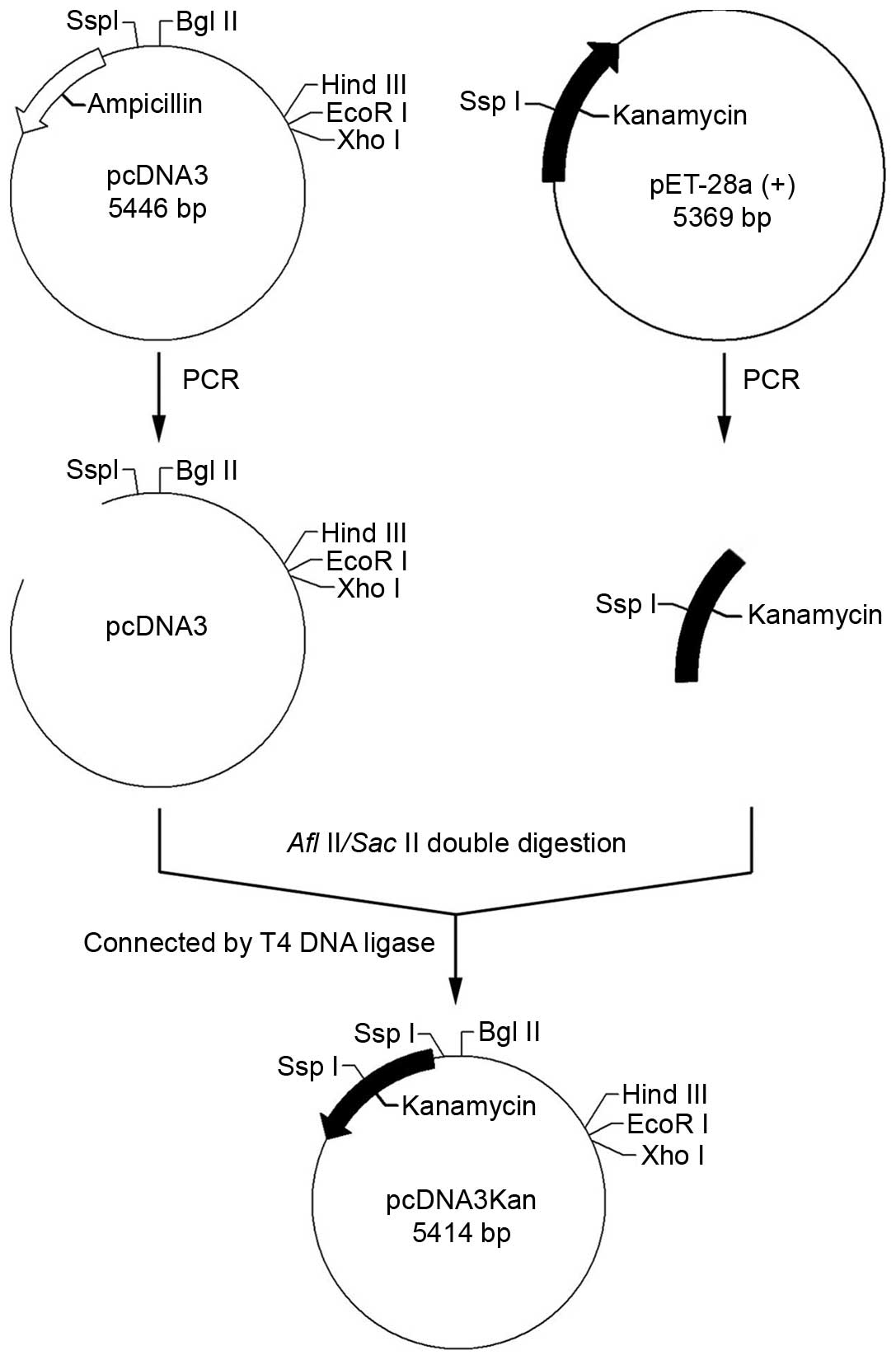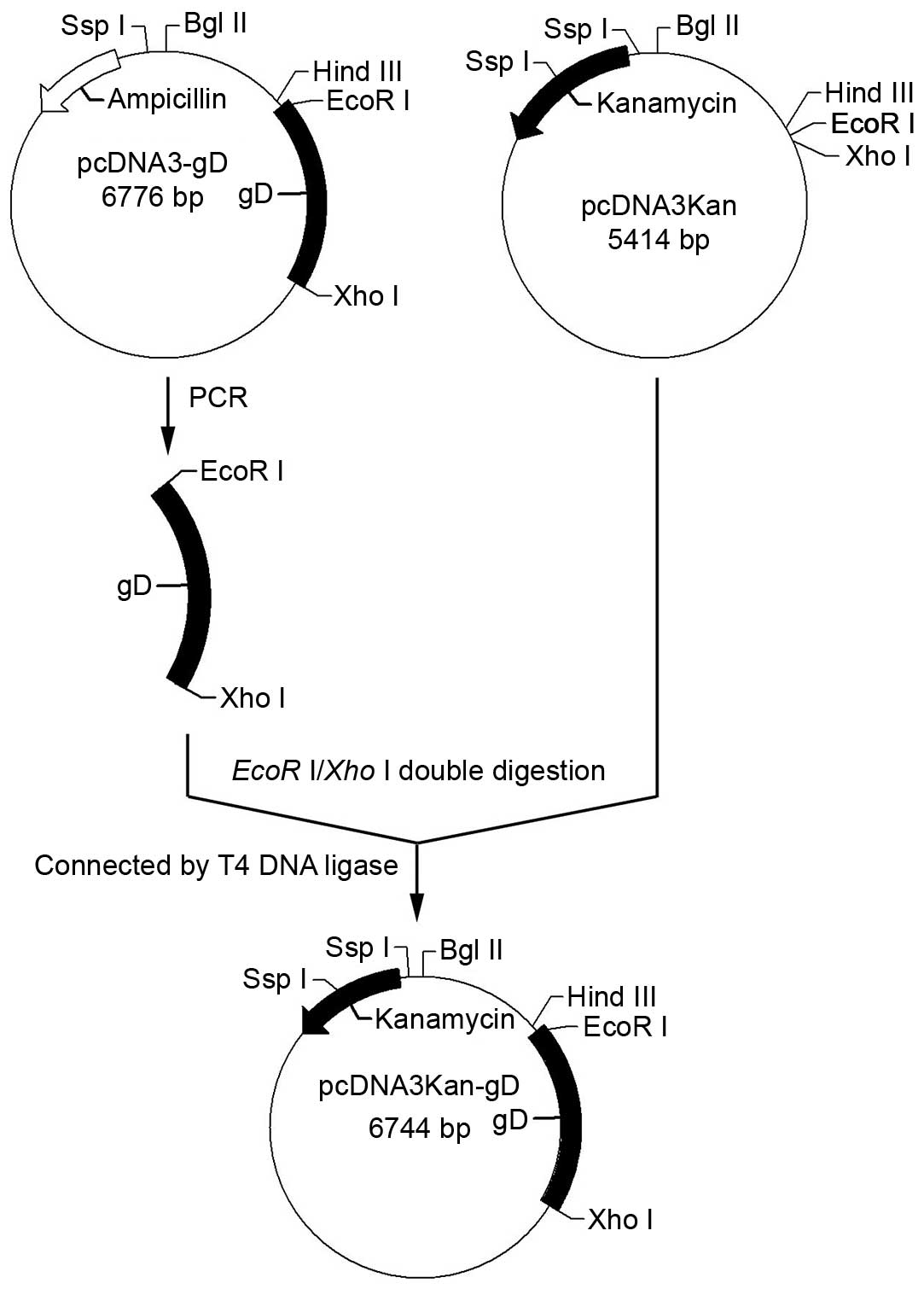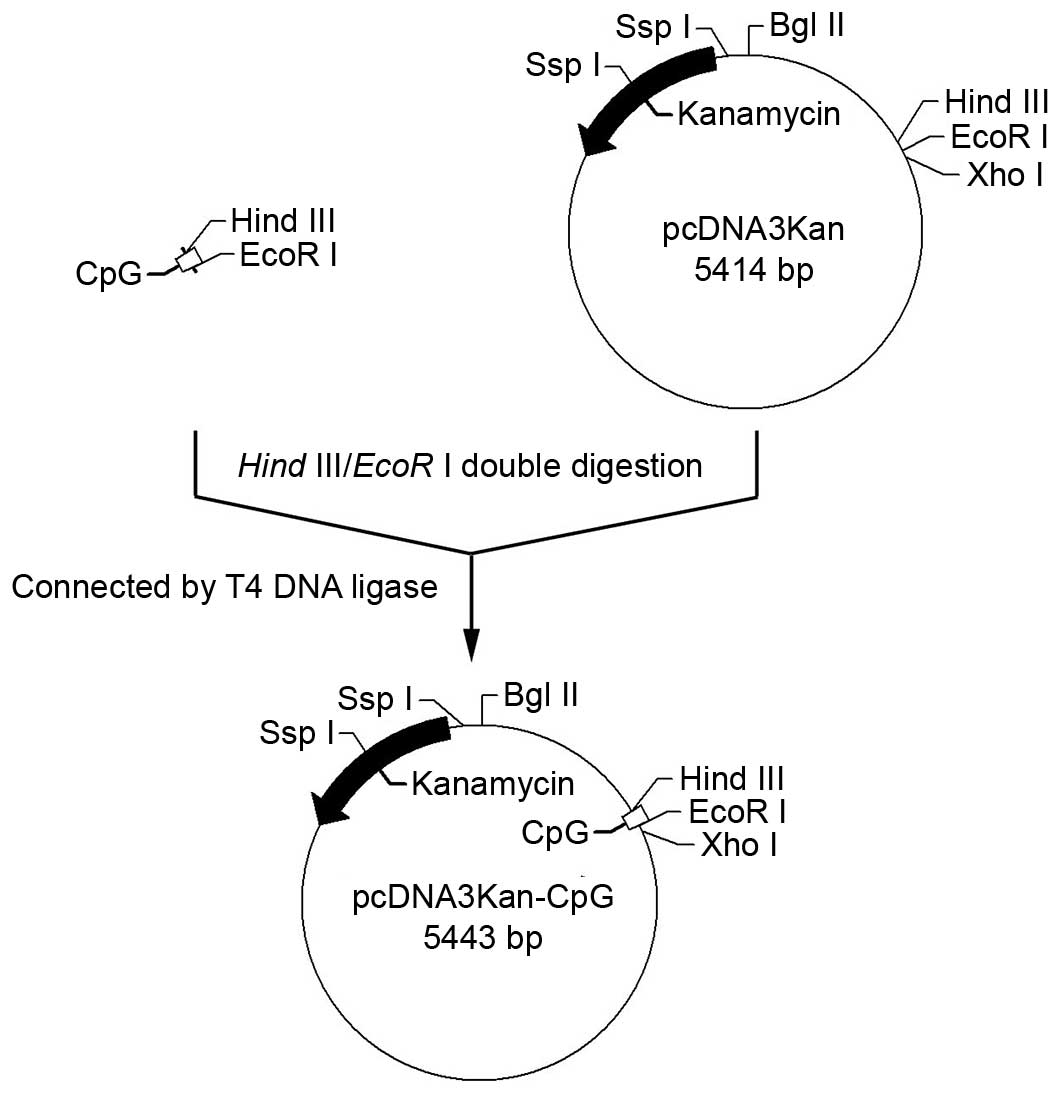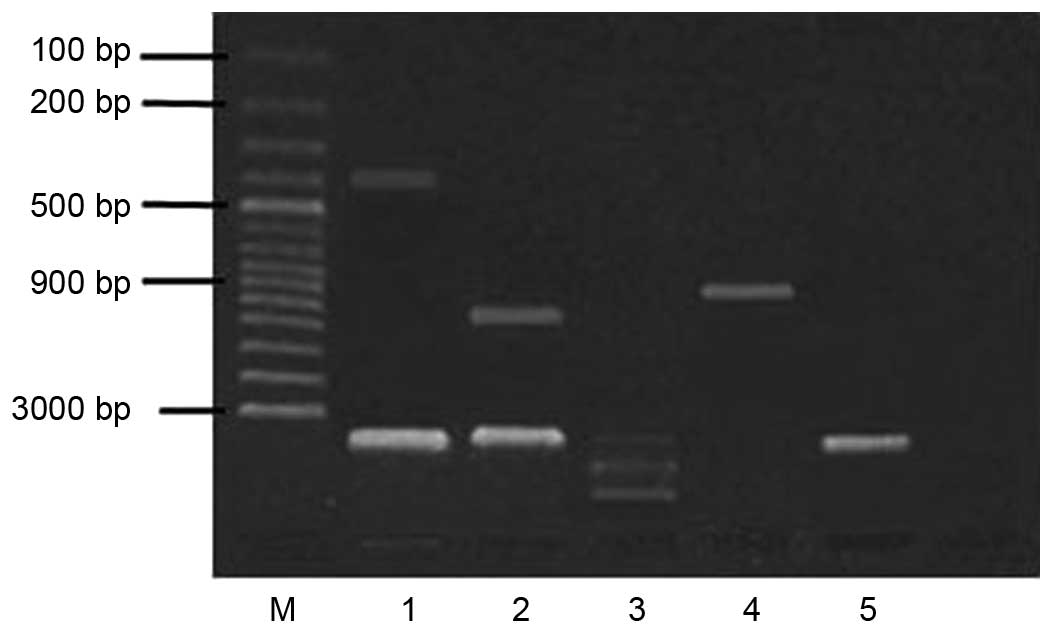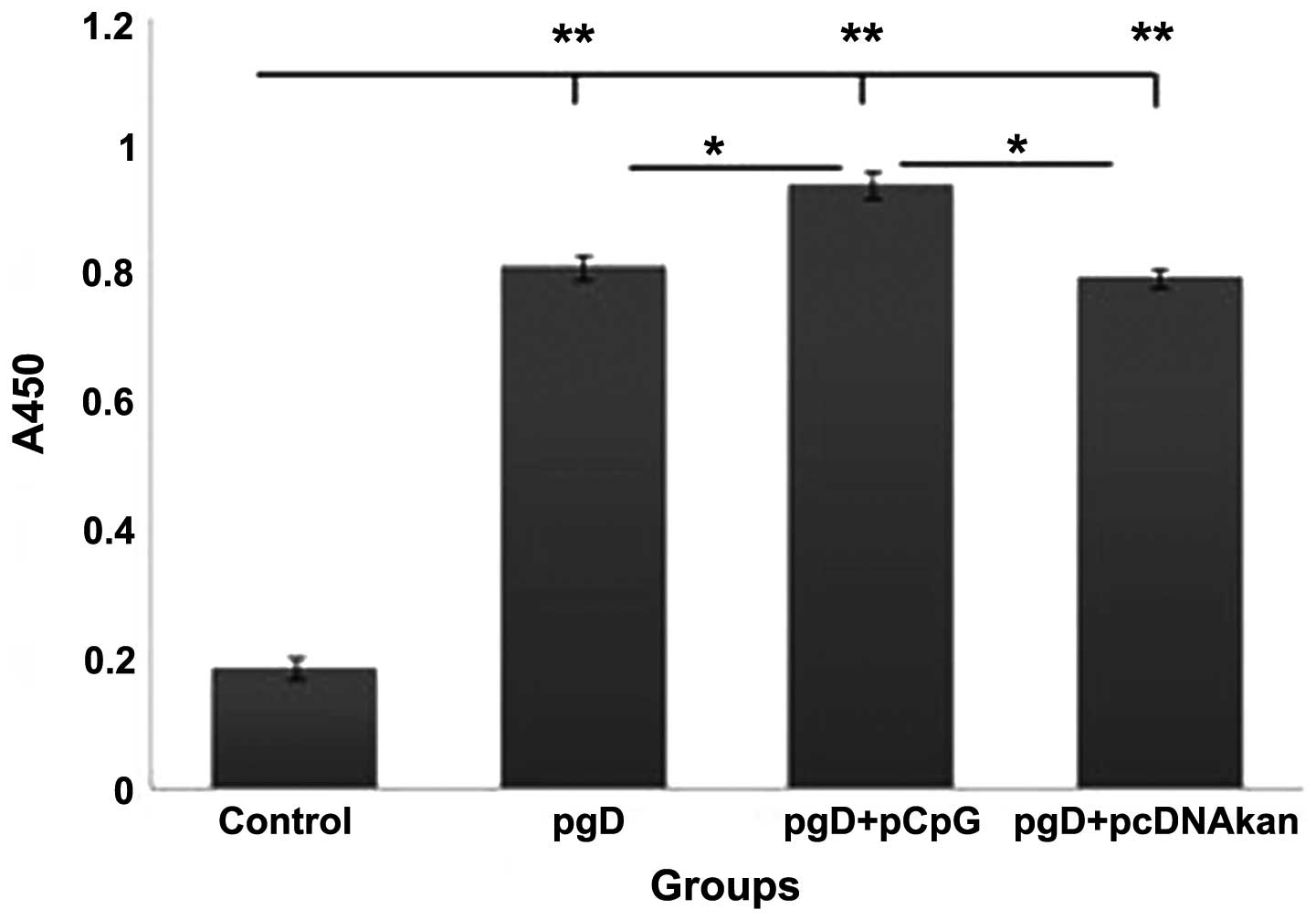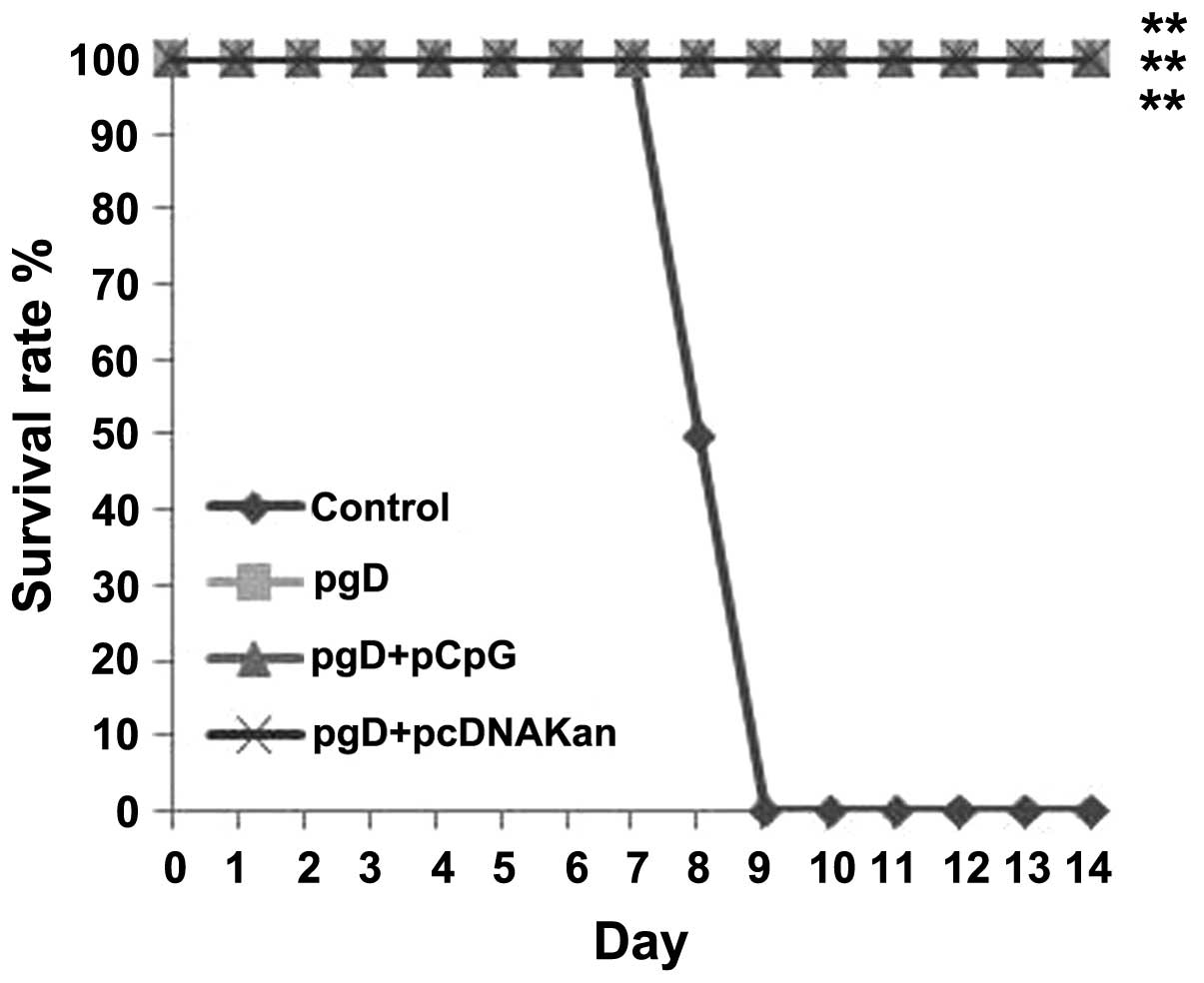A recombinant plasmid containing CpG motifs as a novel vaccine adjuvant for immune protection against herpes simplex virus 2
- Authors:
- Published online on: June 23, 2016 https://doi.org/10.3892/mmr.2016.5439
- Pages: 1823-1828
Abstract
Introduction
Herpes simplex virus type 2 (HSV-2) infection is a common infectious disease in humans. HSV-2 generally causes genital infections. The standard treatment of genital herpes is dependent on guanosine analogues. Despite the efficacy of the treatment, there is still no cure to prevent recurrence. Over the last few decades, considerable efforts have been made to develop a vaccine against genital herpes. Several candidate vaccines have been investigated experimentally in different genital HSV model systems. It is considered that inoculation with a HSV vaccine to promote an immune reaction against HSV is an ideal method to prevent and treat HSV infection.
Previous studies have demonstrated that humoral (1,2) and cellular immune responses (3) are responsible for protective immunity against HSV infection. During viral infection, neutralizing antibodies can inactivate free viral particles, but are unable to inhibit intracellular infection. Furthermore, results indicated that antibodies at the site of mucosal infection were inadequate to prevent invasion (4), which indicated cellular immunity as the main factor involved in the control of HSV infection (5,6). Traditional candidate vaccines such as those containing live attenuated or killed viruses have been shown to confer protective immunity; however, due to safety concerns, the application of these vaccines has been precluded in humans only a few have been assessed in clinical trials (7). HSV recombinant glycoprotein vaccines and subunit vaccines have shown the capacity to stimulate antigen-specific immune responses. However, they were not able to induce efficient cell-mediated immunity, and displayed poor protective immunity in animal models (8). DNA vaccines are the third generation of vaccines following vaccines containing whole pathogen bodies and recombinative protein by gene engineering. DNA vaccines have characteristics of the safety of recombinative sub-unit vaccines and the efficiency of live pathogen vaccines. They can induce humoral and cellular immune responses.
CpG oligodeoxynucleotide (ODN) is a synthetic ODN containing unmethylated cytidine-phosphate-guanosine with appropriate flanking regions (CpG motif). Several recent studies have demonstrated the potent adjuvant activity of CpG ODN in the induction of systemic and mucosal immune responses (9,10). In particular, animal challenge models showed that protective immunity can be accelerated and enhanced by co-administering CpG DNA with vaccines (11). Ongoing clinical studies indicate that CpG ODNs are safe and well-tolerated when administered as adjuvants to humans, and in certain cases they have been shown to increase vaccine-induced immune responses (11).
In the present study, a novel eukaryotic expression plasmid vector was constructed containing the kanr gene from pET-28a(+) and pcDNA3 plasmids. A gene encoding full length HSV-2 gD was cloned into the eukaryotic expression plasmid vector (pgD). A DNA segment containing 8 CpG motifs was also synthesized and cloned into a eukaryotic expression plasmid vector (pCpG). Mice were co-inoculated with pgD and pCpG by bilateral intramuscular injection into the rear leg and the immune response was observed.
Materials and methods
Ethics statement
The study was approved by the Ethics Committee of Zhejiang Academy of Medical Sciences (Hangzhou, China).
Mice
Female Balb/c mice (n=48; weight, 20±2 g; age, ~7 weeks) were provided and bred by the Experimental Animal Center, Zhejiang Academy of Medical Sciences and maintained in a pathogen-free animal facility. Balb/c mice were maintained at 20±2°C, humidity 55±5% with a 12-h dark:light cycle. They were given food pellets (Zhejiang Academy of Medical Sciences, Hangzhou, China) and water ad libitum. Adequate measures were taken to minimize animal discomfort.
Virus
HSV-2 strain Sav, obtained from the National Institute for Viral Disease Control and Prevention (Beijing, China), was grown in Vero cells (Institute of Biochemistry and Cell Biology, Shanghai, China) and was stored at −80°C. Virus was routinely prepared by infection of almost confluent Vero cells (Institute of Biochemistry and Cell Biology) with a multiplicity of infection of 0.1 at 37°C in a small volume of high glucose Dulbecco's modified Eagle's medium (DMEM; Gibco; Thermo Fisher Scientific, Inc., Waltham, MA, USA) without serum. After 1 hr, virus inoculum was removed and cultures were re-fed with high glucose DMEM. Incubation was continued until cytopathic effect was extensive; usually for 24–48 hr. Before use, the virus particles were released from the cells by freezing and thawing cycles and cellular debris was removed by centrifugation (640 × g for 10 min at 4°C). The method of titration was a plaque assay in Vero cells and results were expressed as PFU/ml (12).
Bacterial strains and plasmids
E. coli DH5a and E. coli Tg1 (Beijing ComWin Biotech Co., Ltd., Beijing, China) were used as hosts during the cloning experiments and for propagation of the plasmids. Bacterial strains were grown at 37°C in Luria Bertani (LB) media, supplemented with ampicillin or kanamycin when required. pCDNA3 (Invitrogen; Thermo Fisher Scientific Inc.), pET-28a(+) (Novagen, EMD Millipore, Billerica, MA, USA) and pcDNA3-gD (HSV-2 glycoprotein D gene was inserted) plasmids [pcDNA3-gD (HSV-2 glycoprotein D gene was inserted)] were constructed by the Institute of Bioengineering, Zhejiang Academy of Medical Sciences (13). Plasmids were amplified by E. coli DH5a, purified by the pure plasmid mini kit (Beijing ComWin Biotech Co., Ltd., Beijing, China), and sequenced by Sangon Biotech (Shanghai) Co., Ltd. (Shanghai, China).
Constructing a new eukaryotic expression plasmid vector (pcDNA3Kan) containing the kanr gene from plasmid pET-28a(+) and pcDNA3
The kanr gene was amplified from the pET-28a(+) plasmid by polymerase chain reaction according to standard protocol (14) using the following primers: Forward, 5′-GCCCTTAAGATGAGCCATATTCAACGG-3′ (bold section indicates restriction enzyme site of AflII) and reverse, 5′-AGTCCGCGGTTAGAAAAACTCATCGAG-3′ (bold section indicates restriction enzyme site of SacII). The whole sequence of the pcDNA3 plasmid except the Amp+ gene was amplified from pcDNA3 by PCR according to standard protocols using the following primers: Forward, 5′-GCGGCTTAAGACTCTTCCTTTTTCAAT-3′ (bold section indicates restriction enzyme site of AflII) and reverse, 5′-ATACCGCGGCTGTCAGACCAAGTTTAC-3′ (bold section indicates restriction enzyme site of SacII). The two PCR products that were digested with AflII and SacII were sealed together by T4 DNA ligase and transformed into E. coli DH5a. After selection with kanamycin, a new eukaryotic expression plasmid vector, pcDNA3Kan, was obtained (Fig. 1). The new eukaryotic expression plasmid vector pcDNA3Kan was identified by restriction enzyme BglII/XhoI or SspI digestion analysis.
Cloning of gD into the eukaryotic expression vector pcDNA3Kan
A gene encoding full length HSV-2 gD was amplified from the pcDNA3-gD plasmid by polymerase chain reaction using the following primers: Forward, 5′-ATCGAATTCAACCACTAGTCGCCG-3′ (bold section indicatesrestriction enzyme site of EcoRI) and reverse, 5′-CGCTCGAGACTCCCTTTATGC-3′ (bold section indicates Xho restriction enzyme site of I). The PCR product and plasmid pcDNA3Kan were digested with EcoRI and XhoI. The two DNA strands were then joined at their sticky ends and were sealed together by T4 DNA ligase, to form the recombinant plasmid pcDNA3Kan-gD (pgD) (Fig. 2). The plasmids pgD and pCpG was sequenced by Sangon Biotech (Shanghai) Co. Ltd.
Constructing a new DNA vaccine adjuvant pcDNA3Kan-CpG containing CpG motifs
Two ssDNA segments containing 8 CpG motifs (the sequence of CpG motif was according to ODN 1826): Forward, 5′-AGCTT TCCAT GACGTT CCT GACGTT CCT GACGTT CCT GACGTT CCT GACGTT CCTC GTCGTT TT GTCGTT TT GTCGTT G-3′ (bold section indicates restriction enzyme site of HindIII; underline section indicates CpG motif) and reverse, 5′-AATTC AACGAC AA AACGAC AA AACGAC GAGG AACGTC AGG AACGTC AGG AACGTC AGG AACGTC AGG AACGTC ATGGA A-3′ (bold section indicates restriction enzyme site of EcoRI; underline section indicates CpG motif) were synthesized. The two ssDNA segments were integrated into one DNA double-stranded segment and cloned into the pcDNA3Kan eukaryotic expression plasmid vector using HindIII and EcoRI restriction enzymes, to form a recombinant pcDNA3Kan-CpG (pCpG) plasmid (Fig. 3). The plasmid pCpG was then sequenced.
Immunization and sample collection
Forty-eight mice were divided into the following four groups, with 12 in each group: i) Control, inoculated intraperitoneally with 100 µg pcDNA3Kan; ii) pgD, inoculated intraperitoneally with 100 µg pgD; iii) pgD+pCpG, inoculated intraperitoneally with 100 µg pgD and 30 µg pCpG; and iv) pgD+pcDNA3Kan, inoculated intraperitoneally with 100 µg pgD and 30 µg pcDNA3Kan. All groups were inoculated every 3 weeks for 6 weeks. DNA and adjuvant were all dissolved in normal saline with a final volume of 100 µl. Blood samples (0.5 ml per mouse) were collected at day 14 after each inoculation and divided it into two; one for use in flow cytometry and the other was left standing in room temperature. After standing for 1 h, blood sample were divided into upper and lower layers, the upper of which was the serum and was collected for use in enzyme linked immunosorbent assay (ELISA).
ELISA of antibodies
Serum specimens were assessed for IgG antibodies to HSV-2 using an indirect ELISA method. Using recombinant HSV-2 gD protein (produced in the Institute of Bioengineering, Zhejiang Academy of Medical Sciences) according to a previously described protocol by Zhou et al (15) and affinity-purified polyclonal goat anti-mouse IgG labeled with horseradish peroxidase (HRP; 1:4,000; cat no. 80U00120; Beijing Dingguochangsheng Biotech Co., Ltd., Beijing, China) as antigen and secondary antibody. Absorbance was determined at 450 nm using a Multiskan MK3 (Thermo Fisher Scientific, Inc.).
CD4+ and CD8+ cell subset detection in peripheral blood by flow cytometry
CD4+ and CD8+ cell subset levels were detected in peripheral blood samples by flow cytometry (16) (BD FACSCalibur, BD Biosciences, Franklin Lakes, NJ, USA).
Virus challenge
Karber's method was used to test the lethal dose (LD)50 of HSV-2 strain Sav in Balb/c mice by intraperitoneal injection. All 4 groups of mice were intra-peritoneally injected with 50 LD50 (50/50% lethal dose) HSV-2 strain Sav at days 21 after the third inoculation. Adverse reactions and the number of fatalities were observed daily in the 4 groups of mice after HSV-2 challenge and the results were recorded. All surviving mice were sacrificed at day 14 after HSV-2 challenge.
Statistical analysis
Statistical differences for antibody titers, T lymphocyte assays and the duration of survival were determined using one-way analysis of variance followed by a Bonferroni correction test using GraphPad Prism (version 4; San Diego, CA, USA). P<0.05 was considered to indicate a statistically significant difference. All IgG levels and the percentage of CD4+ or CD8+ T cells are presented as the mean ± standard deviation.
Results
Identification of plasmid vector pcDNA3Kan by restriction enzymes
Based on the gene content of pcDNA3Kan, there are two consensus restriction site sequences (SspI) at ~20 bp upstream of the kanr insertion site and ~360 bp in the kanr gene. pcDNA3Kan treated with SspI showed a 380 bp fragment in agarose gel electrophoresis (Fig. 4). The pcDNA3Kan digested with BglII (existed upstream of the kanr insertion site) and XhoI (existed at multiple cloning sites) showed a 960 bp fragment in agarose gel electrophoresis. Thus, the sequences of pcDNA3Kan were interconnected successfully. The E. coli Tg1 cells transfected with pcDNA3Kan grew well on LB medium supplemented with 50 µg/ml kanamycin. Therefore, the eukaryotic expression vector containing the kanr and gD genes was successfully constructed.
Identification of the recombinant plasmids pgD and pCpG by DNA sequencing
The gD gene in the pgD recombinant plasmids was successfully cloned with the correct open reading fragment. The fragment containing 8 CpG motifs in the recombinant plasmid pCpG had the same DNA sequence as that designed.
Enhancement of the anti-HSV-2-gD titer by pgG+pCpG
Serum anti-HSV-2-gD specific total IgG was assessed by ELISA. As shown in Fig. 5, IgG levels were significantly increased in the pgD+pCpG group, compared with the pgD and pgD+pcDNA3Kan groups (P<0.05), at week 8 post-inoculation. The levels in the control group were significantly reduced compared with the remaining groups (P<0.001).
Difference in CD4+ and CD8+ T cells in each group
To determine the importance of these T cell subsets in the protection of pgD-immune mice against infection with HSV-2, CD4+ and CD8+ T cells were analyzed from all groups prior to virus challenge. As shown in Fig. 6, the percentage of CD8+ T cells from the pgD+pCpG group was only marginally higher than in other groups. However, the percentage of CD4+ T cells in the pgD+pCpG group was significantly higher than in the other groups (P<0.05), particularly compared with the control-treated pcDNA3Kan group (P<0.001).
Protection against HSV-2 challenge
To evaluate the level of protection conferred by immunization, mice were challenged with a lethal dose of 1×105 PFU of HSV-2, 3 weeks following the last immunization. Mice in the pgD, pgD+pCpG and pgD+pcDNA3Kan groups showed significantly higher survival rates compared with the control group (Fig. 7).
Discussion
Mice were intramuscularly immunized with eukaryotic expression plasmids encoding gD to induce protective immune responses (17–19). Certain immune adjuvants such as interleukin-12, chemokines, cytokines and the E. coli heat labile enterotoxin can enhance the immunogenicity of the HSV DNA vaccine (20–23). At present, there is no way to provide complete immunity against HSV in mice, and there is no appropriate HSV vaccine for humans.
The present study designed and constructed a recombinant plasmid pCpG containing 8 CpG motifs. These were investigated as immune adjuvants for a DNA vaccine. According to the results, the recombinant plasmid pCpG in combination with the DNA vaccine could protect mice infected with lethal doses of HSV-2 virus. The HSV-2 antigen specific antibodies were detected by ELISA, and the IgG levels were moderately increased in the pgD+pCpG group, compared with other groups, at week 8 post-inoculation. Peripheral T-lymphocyte subsets were examined by flow cytometric analysis, and the percentage of CD4+ T cells from the pgD+pCpG group was significantly increased compared with the other groups (P<0.05). Test results proved that these mice could induce more notable cellular immunity compared with pgD+pcDNA3Kan and pgD alone in mice.
The experimental results demonstrated that cloning CpG motifs into plasmid DNA is an effective way to apply CpG motifs as adjuvants for DNA vaccines. Sato et al (24) demonstrated that the characteristics of CpG existed in plasmid DNA. Human monocytes transfected with plasmid DNA containing CpG motifs, transcribed large amounts of interferon-α, interferon-β, and interleukin-12. This type of immune response is highly important.
In the present study, a new recombinant plasmid pCpG based on CpG motifs was constructed. pCpG could significantly improve cell-mediated immunity induced by the HSV-2 DNA vaccine. Thus, pCpG has shown great potential as an adjuvant for the HSV-2 DNA vaccine, and may also be used for other DNA vaccines.
Acknowledgments
This study was supported by the Science and Technology Foundation of Zhejiang Province (grant nos. 2011F20015 and 2011C23002), and the Natural Science Foundation of Zhejiang Province (grant nos. LQ12C01002 and LY12H19009).
References
|
Eis-Hübinger AM, Schmidt DS and Schneweis KE: Anti-glycoprotein B monoclonal antibody protects T cell-depleted mice against herpes simplex virus infection by inhibition of virus replication at the inoculated mucous membranes. J Gen Virol. 74:379–385. 1993. View Article : Google Scholar : PubMed/NCBI | |
|
Sherwood JK, Zeitlin L, Whaley KJ, Cone RA and Saltzman M: Controlled release of antibodies for long-term topical passive immunoprotection of female mice against genital herpes. Nat Biotechnol. 14:468–471. 1996. View Article : Google Scholar : PubMed/NCBI | |
|
Milligan GN, Dudley-McClain KL, Chu CF and Young CG: Efficacy of genital T cell responses to herpes simplex virus type 2 resulting from immunization of the nasal mucosa. Virology. 318:507–515. 2004. View Article : Google Scholar : PubMed/NCBI | |
|
Kuklin N, Daheshia M, Karem K, Manickan E and Rouse BT: Induction of mucosal immunity against herpes simplex virus by plasmid DNA immunization. J Virol. 71:3138–3145. 1997.PubMed/NCBI | |
|
Manickan E, Rouse RJ, Yu Z, Wire WS and Rouse BT: Genetic immunization against herpes simplex virus. Protection is mediated by CD4+ T lymphocytes. J Immunol. 155:259–265. 1995.PubMed/NCBI | |
|
McDermott MR, Goldsmith CH, Rosenthal KL and Brais LJ: T lymphocytes in genital lymph nodes protect mice from intravaginal infection with herpes simplex virus type 2. J Infect Dis. 159:460–466. 1989. View Article : Google Scholar : PubMed/NCBI | |
|
Hoshino Y, Dalai SK, Wang K, Pesnicak L, Lau TY, Knipe DM, Cohen JI and Straus SE: Comparative efficacy and immunogenicity of replication-defective, recombinant glycoprotein, and DNA vaccines for herpes simplex virus 2 infections in mice and guinea pigs. J Virol. 79:410–418. 2005. View Article : Google Scholar : | |
|
Ramachandran S and Kinchington PR: Potential prophylactic and therapeutic vaccines for HSV infections. Curr Pharm Des. 13:1965–1973. 2007. View Article : Google Scholar : PubMed/NCBI | |
|
Harandi AM: The potential of immunostimulatory CpG DNA for inducing immunity against genital herpes: Opportunities and challenges. J ClinVirol. 30:207–210. 2004. | |
|
Kwant A and Rosenthal KL: Intravaginal immunization with viral subunit protein plus CpG oligodeoxynucleotides induces protective immunity against HSV-2. Vaccine. 22:3098–3104. 2004. View Article : Google Scholar : PubMed/NCBI | |
|
Harandi AM: The potential of immunostimulatory CpG DNA for inducing immunity against genital herpes: Opportunities and challenges. J Clin Virol. 30:207–210. 2004. View Article : Google Scholar : PubMed/NCBI | |
|
Spear PG and Roizman B: Proteins specified by herpes simplex virus. V. Purification and structural proteins of the herpesvirion. J Virol. 9:143–159. 1972.PubMed/NCBI | |
|
Hong Y, Yang LH, Chen Y, Jing L, Jiang JH and Wang YT: Immune response induced by herpes simplex virus-2 DNA vaccine in mice. Chin J Publ Health. 19:1079–1080. 2003. | |
|
Sambrook J and Russell D: Molecular Cloning: A Laboratory Manual. 3rd Edition. Cold Spring Harbor Laboratory Press; New York: pp. 1632001 | |
|
Zhou C, Cao CL, Fan JY and Yang HL: Prokaryotic expression of full length HSV-2 gD antigen and its antienicity. J Pract Med. 24:1668–1670. 2008. | |
|
Prince HE, Arens L and Kleinman SH: CD4 and CD8 subsets defined by dual-color cytofluorometry which distinguish symptomatic from asymptomatic blood donors seropositive for human immunodeficiency virus. Diagn Clin Immunol. 5:188–193. 1987.PubMed/NCBI | |
|
Görander S, Ekblad M, Bergström T and Liljeqvist JÅ: Anti-glycoprotein g antibodies of herpes simplex virus 2 contribute to complete protection after vaccination in mice and induce antibody-dependent cellular cytotoxicity and complement-mediated cytolysis. Viruses. 6:4358–4372. 2014. View Article : Google Scholar : PubMed/NCBI | |
|
Awasthi S, Balliet JW, Flynn JA, Lubinski JM, Shaw CE, DiStefano DJ, Cai M, Brown M, Smith JF, Kowalski R, et al: Protection provided by a herpes simplex virus 2 (HSV-2) glycoprotein C and D subunit antigen vaccine against genital HSV-2 infection in HSV-1-seropositive guinea pigs. J Virol. 88:2000–2010. 2014. View Article : Google Scholar : | |
|
Delagrave S, Hernandez H, Zhou C, Hamberger JF, Mundle ST, Catalan J, Baloglu S, Anderson SF, DiNapoli JM, Londoño-Hayes P, et al: Immunogenicity and efficacy of intra-muscular replication-defective and subunit vaccines against herpes simplex virus type 2 in the mouse genital model. PLoS One. 7:e467142012. View Article : Google Scholar | |
|
Sin JI, Kim JJ, Arnold RL, Shroff KE, McCallus D, Pachuk C, McElhiney SP, Wolf MW, Pompa-de Bruin SJ, Higgins TJ, et al: IL-12 gene as a DNA vaccine adjuvant in a herpes mouse model: IL-12 enhances Th1-type CD4+ T cell-mediated protective immunity against herpes simplex virus-2 challenge. J Immunol. 162:2912–2921. 1999.PubMed/NCBI | |
|
Eo SK, Lee S, Chun S and Rouse BT: Modulation of immunity against herpes simplex virus infection via mucosal genetic transfer of plasmid DNA encoding chemokines. J Virol. 75:569–578. 2001. View Article : Google Scholar : PubMed/NCBI | |
|
Lee S, Gierynska M, Eo SK, Kuklin N and Rouse BT: Influence of DNA encoding cytokines on systemic and mucosal immunity following genetic vaccination against herpes simplex virus. Microbes Infect. 5:571–578. 2003. View Article : Google Scholar : PubMed/NCBI | |
|
Haynes JR, Arrington J, Dong L, Braun RP and Payne LG: Potent protective cellular immune responses generated by a DNA vaccine encoding HSV-2 ICP27 and the E. coli heat labile enterotoxin. Vaccine. 24:5016–5026. 2006. View Article : Google Scholar : PubMed/NCBI | |
|
Sato Y, Roman M, Tighe H, Lee D, Corr M, Nguyen MD, Silverman GJ, Lotz M, Carson DA and Raz E: Immunostimulatory DNA sequences necessary for effective intradermal gene immunization. Science. 273:352–354. 1996. View Article : Google Scholar : PubMed/NCBI |



